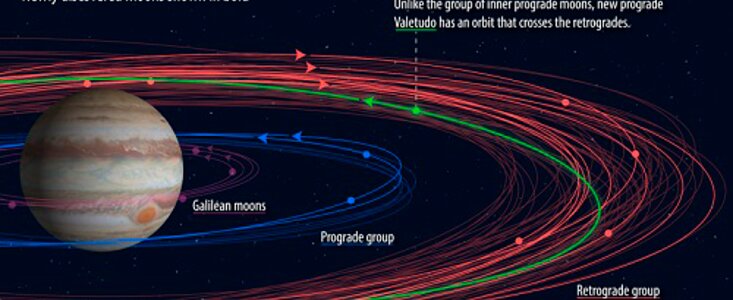Gemini Confirms Maverick New Moon of Jupiter
17 Julio 2018
Scientists announced the discovery of 12 new moons orbiting the planet Jupiter, including one that bucks the trend by orbiting in the opposite direction from others of its ilk. Gemini observations confirmed this jovian oddball, dubbed Valetudo, after the great-granddaughter of the god Jupiter.
The Gemini director’s discretionary observations were made using the Gemini Multi-Object Spectrograph (GMOS) on the Gemini North telescope atop of Hawaii’s Maunakea.
Read more about this discovery in the Association of Universities for Research in Astronomy (AURA) press release that follows.
Scientists using National Science Foundation Observatories find 12 new moons of Jupiter
Sometimes you find something you weren’t even looking for. A team of scientists led by Carnegie’s Scott S. Sheppard, during a search to find very distant Solar System objects, just announced the discovery of twelve new moons orbiting Jupiter. The moons were first found in the spring of 2017 when the team was using the Dark Energy Camera to look for evidence of a ninth planet in our solar system, and Jupiter was luckily in the search field.
The Dark Energy Camera is mounted on the 4-meter Victor Blanco Telescope at the Cerro Tololo Inter-American Observatory in Chile which is operated by the National Optical Astronomical Observatory funded by the National Science Foundation through a cooperative agreement with Association of Universities for Research in Astronomy (AURA.) The Dark Energy Camera searches a large area when in its survey mode, and for these observations, the survey field just happened to be near Jupiter – that is the best way to find small moving objects like these moons.
“If all these new moons are confirmed, that will bring Jupiter’s total haul to an eye-popping 81 moons!” commented Heidi Hammel Executive Vice President of AURA and a James Webb Space Telescope interdisciplinary scientist. She continued, “With the recently announced delay of the James Webb Space Telescope, we have some time to see if any of these newly-discovered moons can be fit into our initial observing program. With the power of the Webb Telescope, we might be able to discern some aspects of their surface composition.”
Gemini North telescope in Hawaii, also supported by the National Science Foundation through a cooperative agreement with AURA, was used to confirm an oddball moon, named Valetudo after the Roman god Jupiter’s great-granddaughter, the goddess of health and hygiene. Valetudo is considered an oddball because of its inclined prograde orbit that crosses the paths of the outer retrograde moons.
“Our other discovery is a real oddball and has an orbit like no other known Jovian moon,” Sheppard explained. “It’s also likely Jupiter’s smallest known moon, being less than one kilometer in diameter”.


